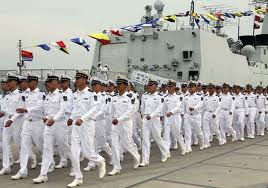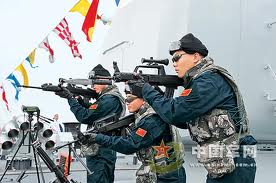China’s rising economic and military might is worrying the US, India and Australia, says political analyst Jawhar Hassan
![[½¨¾ü£¸£°ÖÜÄê]£¨1£©º£¾üÐÂÒ»´úºóÇÚ×°±¸±£ÕÏÑÝÁ·¼Íʵ](http://dinmerican.files.wordpress.com/2011/12/chinese-navy.jpg?w=300&h=200) SOUTHEAST Asia has been an arena for major power contests since the 14th century, when advances in naval and military technology enabled European powers to forage in distant continents for territory, resources and power.
SOUTHEAST Asia has been an arena for major power contests since the 14th century, when advances in naval and military technology enabled European powers to forage in distant continents for territory, resources and power.
This contest for strategic influence and military dominance has waxed and waned through the colonial era, two world wars, the independence period and the Cold War. It never really diminished subsequently in the Eurasian, Middle Eastern/North African (Mena) and East Asian theatres.
But in this region, the rivalry that has been mounting in the last decade is gaining added pace as global economic power, hitherto concentrated primarily in the West, is dispersing to other parts of the world.
The immediate catalyst for the region has been the economic resurgence of China, which has enabled it to embark on a programme of sustained military modernisation and enhancement.
enabled it to embark on a programme of sustained military modernisation and enhancement.
The most recent developments were manifestly in response to aggressive Chinese behaviour with regard to disputes arising from claims in the region. The United States has adopted a more assertive stance in the area, partly in response to urging from some Southeast Asian claimant states. It also announced in May a plan to station new littoral combat ships in Singapore. Last month, it declared that up to 2,500 American Marines are to be positioned in Darwin, Australia.
Beijing, for its part, cites several reasons for enhancing its military capabilities. It points to the severe imbalance in military power that exists in the region. Its military inventory is dated; its navy is qualitatively inferior compared even with those of Japan, India and Australia, not to mention the US; and military alliances and strategic partnerships encircling China are being further augmented.
It also claims the same right to modernise and build its equipment to meet its security needs that other growing economies in the region are legitimately exercising.
 However valid these arguments may be, China's actions have raised concerns in various quarters. Japan, the US, India and Australia are among the most concerned. In Southeast Asia, disquiet is greatest among Vietnam, the Philippines, Singapore and Indonesia. Malaysia is not unconcerned, too. China's recent assertiveness, allied with its growing military clout , is a source of worry for all the states.
However valid these arguments may be, China's actions have raised concerns in various quarters. Japan, the US, India and Australia are among the most concerned. In Southeast Asia, disquiet is greatest among Vietnam, the Philippines, Singapore and Indonesia. Malaysia is not unconcerned, too. China's recent assertiveness, allied with its growing military clout , is a source of worry for all the states.
The unfolding situation is a classic illustration of the security dilemma and spiral model theories in international relations, which posit that actions and reactions beget other actions and reactions that aggravate the situation. This often involves the adoption of policies that only help fulfil their worst assumptions. A corollary is that, contrary to customary assertions that instability is caused by ascendant powers threatening the status quo, instability may equally be created by reigning hegemons reluctant to make space.
In this complex situation, where contending major power interests are enmeshed with the diverse vital interests of regional states, ASEAN will do well to tread an astute and independent path.
This will not be easy in a region that has succumbed to major power domination and conflict before, has its own internal rivalries and territorial disputes, and where its members are often tilted to one major power or oth er.
before, has its own internal rivalries and territorial disputes, and where its members are often tilted to one major power or oth er.
One factor above all must be clear to ASEAN: lasting peace, durable stability and sustained prosperity for the region will be predicated upon three vital factors.
First, upon cultivating amicable and productive relations with all external powers. The region's long-term strategic interests are irrevocably and intimately tied to developing the closest economic and strategic ties with all major powers. The region stands to gain enormously from each and every one of them.
Second, upon actively moderating the rivalry among the major powers rather than in being passive onlookers or worse, becoming willing collaborators or unwitting pawns in the major power game. As anchors of the ASEAN Regional Forum, the ASEAN Plus Three process and the East Asia Summit, and as crafters of the ASEAN Charter, the Treaty of Amity and Cooperation and a revitalised Zone of Peace, Freedom and Neutrality (Zopfan) attuned to the demands of the 21st century, nothing less is expected of ASEAN and its individual members.
And third, upon alleviating flashpoints in the South China Sea that can embroil not only the claimant states but outside powers as well. This can be done by convincing China that a legally-binding code of conduct is aimed only at putting in place a regime for order and avoidance of conflict that is mutually beneficial to all parties, and does not prejudice the territorial claim of any country.
Absent such a moderating instrument, Beijing will continue to pay a heavy political and security price for what many regard as its legally dubious claims in the South China Sea.
If disputes in the area can be thus pacified, Southeast Asia will be less of an arena for major power contention.

No comments:
Post a Comment